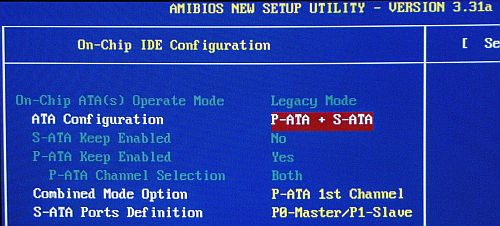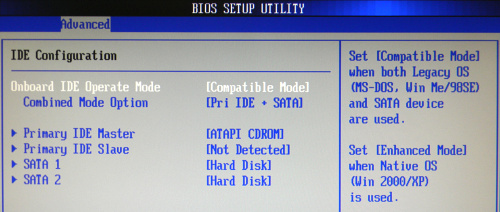

Last modified: Sun Jun 2 10:41:51 EDT 2019
Preface
Introduction
BIOS setup
Partitioning and formatting
Windows 98 Setup
Patch for hang-on-shutdown
Problems installing Nvidia drivers
Vanilla DOOM with a PCI sound card
Resources
Since I originally posted the story of how I installed Windows 98 SE on my "new" Pentium 4 PC way back when, I've learned a lot about installing W98SE on both older and newer systems. Consequently, much of the material that was here has been moved to or superseded by general configuration notes for DOS, W98SE, and ISA-era BIOS. There is also a story about installing W98SE on my new PC, Windows 98 SE and FreeDOS on Wildcat Point.
Despite great advances from Windows NT through Windows 2K and then XP, my first impression of Windows 98 upon returning to it after all these years was "Wow, great upgrade!" It's simpler, smaller, and faster than XP; it runs my favorite game (Classic DOOM); and, it's immune to the kind of troubleshooting nightmare—you know, that bang-your-head-for-hours, occasionally yelling "WHY IS IT DOING THIS?!?" at the ceiling kind of troubleshooting nightmare—that the obscurity and complexity of NT/2K/XP et seq. engender. W98 isn't perfect, heck no, but like an older model car, it is possible for a mere mortal to understand its workings and fix it when it breaks. That is a Good Thing.
The original protagonist of this article, which was my workhorse PC for 10 years, is of late 2004 vintage and uses the 865PE chipset released the previous year. W98 drivers for the motherboard chipset (especially the AC97 audio) and the GeForce 6-series video card were available, so with some careful configuration choices it was possible to run W98 on it with relatively little loss of functionality. Two somewhat newer P4 chipsets that I experimented with later had no W98 driver support at all but could boot to desktop.
| Chipset | Chipset release date | Motherboard(s) tested |
|---|---|---|
| 865PE | 2003-05 | MSI 865PE Neo3-F / ASRock ConRoe865PE |
| PT880 Ultra | 2005-01 | ASRock 4CoreDual-SATA2 |
| nForce 750i SLI | 2007 | Asus P5N-D |
The following problem cropped up on the 865PE chipset, but (quite unexpectedly) failed to crop up on the two newer chipsets.
With default BIOS settings, I got two reboots into the installation process and then it hung. With BOOTLOG.TXT output enabled, the end of the log looked like this:
[0015B6D2] Initing hsflop.pdr [0015B6F1] Init Success hsflop.pdr [0015B6F1] Initing esdi_506.pdr [0015B6F7] Init Success esdi_506.pdr [0015B6F8] Initing esdi_506.pdr [0015B703] Init Success esdi_506.pdr [0015B703] Initing esdi_506.pdr
esdi_506 is identified as the Windows protected mode IDE disk driver. The problem, apparently, was that the mixture of SATA and PATA interfaces didn't satisfy W98's outdated assumptions about ports and IRQs.
To avoid this problem, I had to configure the BIOS to use "Legacy Mode," "Compatible Mode," or "IDE" rather than "Native Mode," "Enhanced Mode," or "AHCI" for its ATA channels. This limits you to four devices, but they don't all have to be PATA. The BIOS can map two SATA drives onto an emulated IDE channel.
(From two different AMI BIOSes:)

|

|
Beware that changing this configuration on a working system will probably
kill an installation of Windows XP. If Linux stops booting, you just
need to boot off the installation CD and update the device names in
/etc/fstab. A preemptive change to use filesystem volume labels instead
of device names should prevent it from breaking in the first place. See
man fstab.
The BIOSes on the PT880 Ultra and 750i motherboards did not present this compatibility option, but they didn't need it; W98 just worked.*
* Actually, it turned out that W98 installations on the PT880 Ultra get stuck at a BSOD about half of the time, and the guilty driver is "Standard Dual PCI IDE Controller." The rest of the time, however, it just works with no changes.
The regular W98 install process in which it automatically formats a partition before running setup seldom works at all with a larger disk and often trashes the disk before failing. If you FORMAT /S the partition from a boot floppy first, you can then run setup and skip the formatting steps.
At the time I was using the original W98SE FDISK and FORMAT programs, which are very fragile and buggy around large disks. For better (but still buggy) results, use the patched-up IO.SYS from kb311561 and this unofficial hack of FDISK (kb263044) and FORMAT, and follow the procedures here.
When setup finishes its first phase, you are instructed to remove the floppy (meaning take the CD out) and reboot. Since I had more than 1 GiB of memory, the installer now halted with the message "Insufficient memory to initialize windows." As described in kb184447 *, the workaround was to add the following setting to WINDOWS\SYSTEM.INI:
[386Enh] MaxPhysPage=30000
Instead of just taking the CD out, you can swap it for a Linux installation CD, boot that and make the edit to WINDOWS\SYSTEM.INI with vi, THEN let W98 boot itself.
A related problem with the same symptom is described in kb253912, but I did not need to change the MaxFileCache setting at this point. (I did later, though, to get the Nvidia drivers to install.)
* kb184447 claims to apply only to Windows 98 Standard Edition, not to Second Edition, but the fix still works.
From Microsoft Article 239887 rev. 2.4:
You may experience any of the following symptoms when you select an option in the Shut Down Windows dialog box.
- If you click Shut down and then click OK, the computer may stop responding (hang) while displaying the following message:
Windows is shutting down.- If you click Restart in MS-DOS mode and then click OK, the computer may hang while displaying a blank screen.
- If you click Shut down or Restart in MS-DOS mode and then click OK with fast shutdown enabled, the computer may restart instead of shutting down.
To fix these problems, Microsoft released the Windows 98 Second Edition Shutdown Supplement which is a 504 KiB patch named 4756US8.EXE:
4756US8.EXE: MD5 = BA 65 D8 9B 85 43 56 96 4F EB 25 90 5A 44 FB E7
4756US8.EXE: SHA1 = 332B BA76 54FD FC3B C72C B3E7 D1CF B225 17BC EDC1
4756US8.EXE: RMD160 = EE9B C87D 5750 48BC 6C5E AD6F 94CF 207B 9695 9B53
4756US8.EXE: SHA224 = A1954434 99974266 6DD00C81 E6ECCE53 854AF7CF 7F598E96
24CC0E79
4756US8.EXE: SHA256 = B7C906C4 EB134019 3D28651E BF446F4F E72D5B31 7B9C52AA
81F3DBA4 7EA245C3
4756US8.EXE: SHA384 = 68284670 F8A2608B 263A71AC ABF59970 0E96E3A5 311E5E7B
98651016 FAB2BB13 F42504DE EFD5F64B 5218C305 4C17CA93
4756US8.EXE: SHA512 = CE9A1998 BB4A1D62 4B8D2CEA 2F3D12AA 45ECF694 A357220F
DD842592 3E2C6F69 DE7EDBE2 9F6FBB7C 4BCC0B1F 54FD7F3E
52226C9B D880908A F8716A88 9CD5FE19
Unfortunately, most of the links to it on the Microsoft web site are currently broken, but this ugly one still works: http://download.microsoft.com/download/d/d/8/dd8e4f2d-3b66-41d7-8a4a-cefefd8deb2c/4756US8.EXE
If that link breaks too, well, here's a cached copy.
Infinite problems getting the Nvidia drivers to install without everything becoming FUBAR were actually just a symptom of generalized memory-configuration-related instability that was triggered by having more than 512 MiB of RAM. On the 865PE PC with 4 GiB RAM, dramatic improvement occurred when I installed HimemX version 3.32 in CONFIG.SYS (displacing the HIMEM.SYS that came with Windows 98 SE) as recommended by some folks on the Microsoft Software Forum Network. To achieve complete stability, I also had to set a value for MaxFileCache in SYSTEM.INI. However, after doing that, I was able to increase MaxPhysPage to 40000 (1 GiB) without problems.
Working configuration for 865PE:
| Motherboard | MSI 865PE Neo3-F | |
| CPU | Pentium 4 540 3.2 GHz (Prescott) | |
| RAM | 4 GiB DDR PC-3200 | |
| Audio | Onboard Realtek ALC850 8-CH Audio | |
| Video | eVGA GeForce 6800 GT, 256 MiB GDDR3, AGP 8X | |
| AGP aperture | 256 MiB | |
| CONFIG.SYS | DEVICE=C:\HIMEMX.EXE | |
| AUTOEXEC.BAT | (empty) | |
| MaxPhysPage | 40000 (1 GiB) | |
| MaxFileCache | 131072 (128 MiB) | |
| OS | Windows 98 SE | |
| OS patches | Shutdown Supplement | |
| Drivers etc. |
INF 6.3.0.1007 20041216 from Intel DirectX 9c from Microsoft Realtek AC97 MB 5.10.00.6230 20070508 from MSI HimemX v3.32 from Japheth (original site now gone) Forceware 81.98 from Nvidia |
With this configuration I was able to run DOOM 95 with no loss of functionality. Yay. Unfortunately, the motherboard sound drivers weren't really DOS-compatible, though they claimed to be—in DOS DOOM there was no music and the sound effects were crackly.
2013-01: With a different motherboard (MSI 865PE Neo3-F → ASRock ConRoe865PE), a 6800 Ultra EE, a widescreen LCD monitor and a Montego II A3D PCI sound card installed, I decided to see if I could get Vanilla DOOM to run with full music and sound.
The Sound Blaster Pro 2.0 emulation of the Montego II A3D worked eventually, but the drivers were troublesome.
Video regressions:
Other issues:
In summary, although I got Vanilla DOOM with music and sound effects technically functional on a P4 system without an ISA slot or DOSBox, better results are obtainable with less effort by sticking with ISA and plain DOS.
See here for summaries of mostly negative Sound Blaster emulation results for other PCI sound cards. These PCI cards are really picky about which motherboards they will work on.
For all the other official and unofficial W98 patches and as much support as you're going to get, visit the Microsoft Software Forum Network.